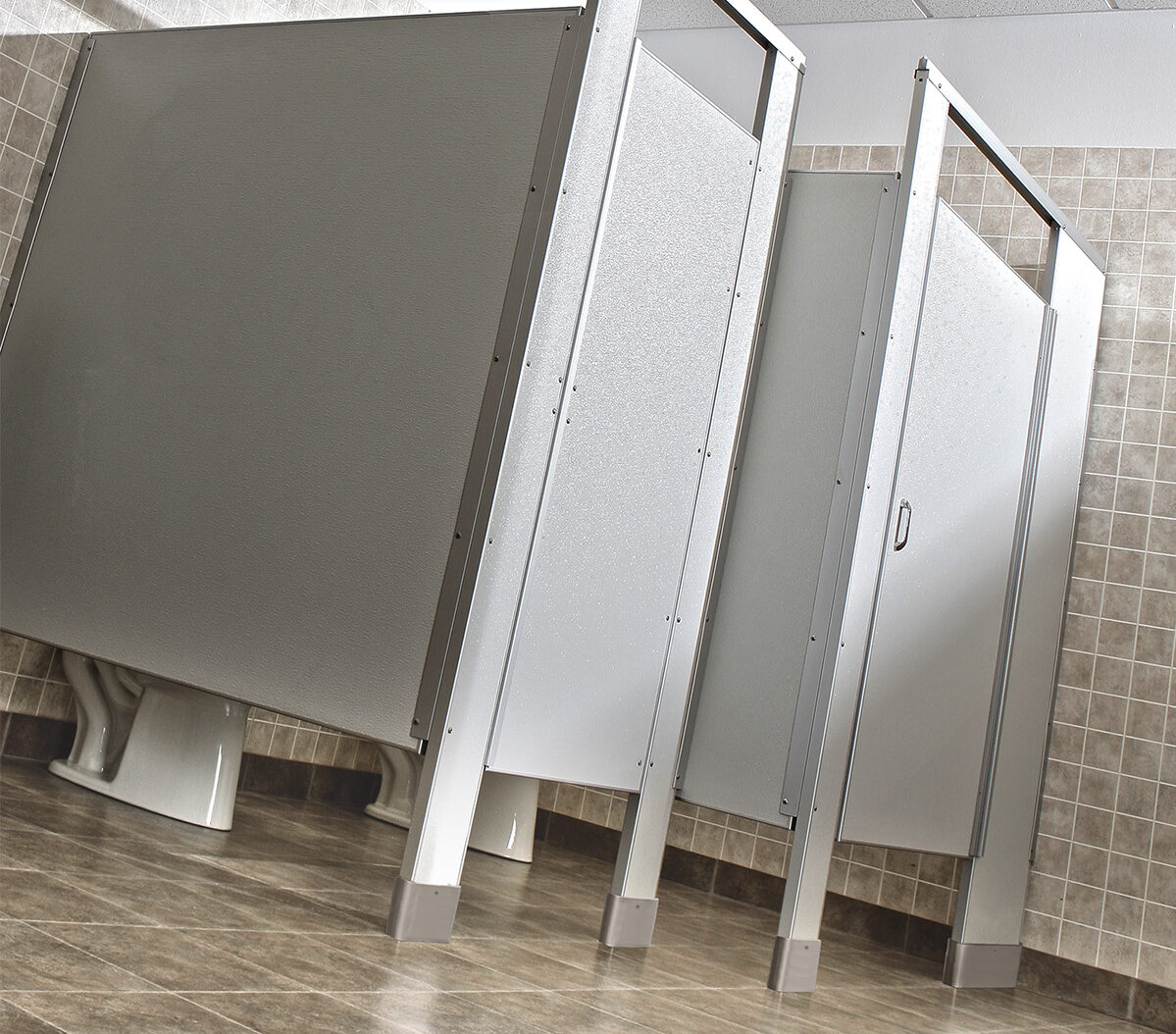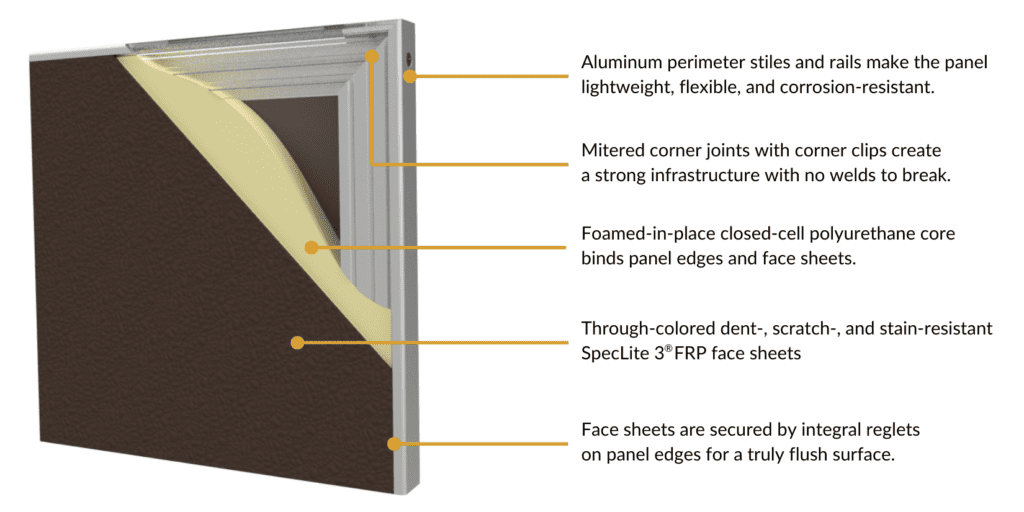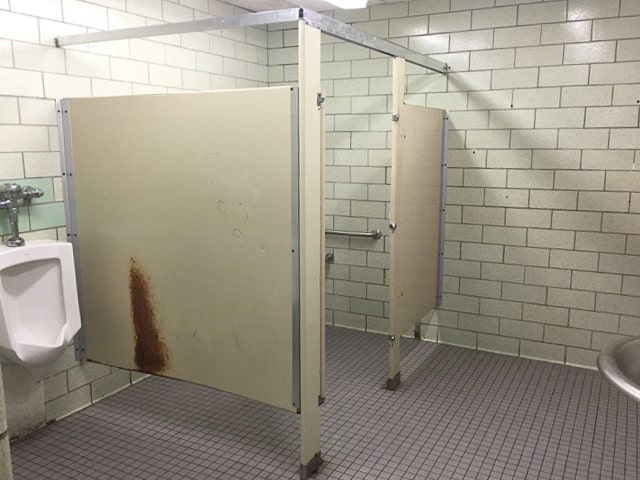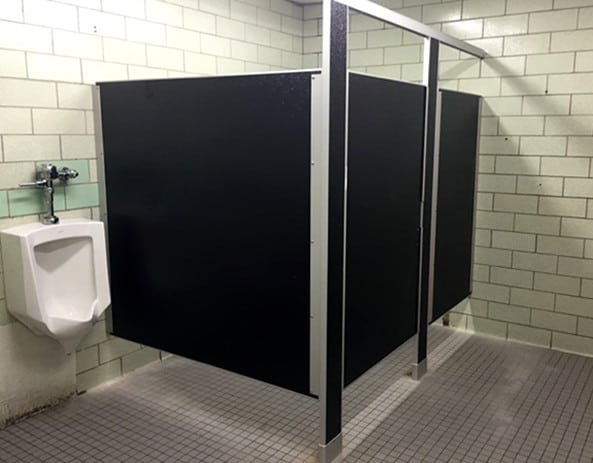
What are the different types of materials used for commercial bathroom partitions? Here is a Comparison
When designing or enhancing your commercial space, attention to detail is crucial. One often overlooked yet essential aspect is the selection of materials for bathroom partitions. These unassuming dividers or bathroom stalls ensure privacy and functionality while working within your overall look in a public restroom. Yes, we may be more widely known as a custom, durable commercial door manufacturer (our SL-17 is a perfect example), but we also applied that technology to this area. Here, we delve into what is used to manufacture different commercial bathroom partitions, highlighting their features, benefits, and potential drawbacks.

FRP (Fiberglass Reinforced Plastic)
FRP partitions are not only lightweight but are also resistant to moisture and chemicals. You build them by reinforcing layers of fiberglass with thermosetting resins, resulting in a strong material that can take almost all kinds of abuse. FRP partitions are incredibly easy to clean and maintain in facilities that value sanitation and cleanliness (that includes the healthcare industry, schools, restaurants, and more).
Restroom partitions from Special-Lite take it a step further with a graffiti-resistant surface sealant, SpecLite 3®, and, for optimal strength, aluminum extrusions. A closed-cell foam core binds all components together while keeping the panel lightweight yet incredibly strong. This same technology extends to shower rooms, privacy panels (or urinal screens), changing rooms, and locker rooms – all great use cases!
Phenolic
Phenolic bathroom partitions are tough and resilient. Constructed with multiple layers of resin-impregnated kraft paper, these partitions are usually coated with clear melamine. This makes them resistant to moisture, impact, and vandalism. They tend to show more surface wear, which means that bathroom stall scratches may be difficult to remove and could lead to ghosting.
Phenolic partitions come in a handful of colors, but for an additional cost, custom choices can be a possibility. Privacy options are typically an add-on feature. A larger team will also be needed to complete an installation, as phenolic partitions tend to be heavy. Consider weight (and installation) when looking at this option.
Powder Coated Steel
Powder-coated steel partitions strike a balance between durability and affordability as they can dent. A honeycomb cardboard core rests between textured sheet metal treated with a powder overlay that enhances visual appeal. These partitions are somewhat easy to clean and maintain, making them a popular choice for many commercial spaces not prone to vandalism. However, they are usually recommended for areas with low moisture due to their vulnerability to rust.

Before Special-Lite Bathroom Partitions: Exposure to liquids causes rust and creates sanitizing challenges. These metal panels have been bent and vandalized with permanent markers.
Stainless Steel
Stainless steel bathroom partitions are usually chosen to help create a sophisticated and modern look. They offer corrosion resistance for low-moisture environments, are easy to clean, maintain their appearance over time, and are favored by some for their hygienic properties. They are often among the more expensive options for a bathroom stall.
Plastic Laminate
Plastic laminate partitions can provide a cost-effective solution. These partitions are made by fusing resin-soaked paper or particle board layers under high pressure. They offer a wide range of color options. Plastic laminate is easy to clean, making it suitable for areas with moderate foot traffic. They may not be ideal for areas with high moisture. A stall with this material can have gaps, but you can add privacy options – typically as an added cost.
Solid Plastic
Solid plastic partitions (HDPE) are made from a polymer material resistant to moisture, impact, and graffiti. These partitions are long-lasting and ideal for facilities prone to heavy use. They resist scratches and dents, maintaining a clean appearance initially, but can be susceptible over time. These partitions may not come in as many colors as other materials, and this option is also not the lightest, something to think carefully about when installing and choosing your hardware. Dirt and grime can also gather in visible joints and seams after a while, which could present cleaning challenges.
Choose a Material Suited for Your Needs
The material for commercial bathroom partitions should be a well-considered decision based on your needs. Consider durability, aesthetics, maintenance, and budget in the short and especially the long term. By understanding the characteristics of different types of restroom partitions, architects, designers, and facility managers can create bathroom spaces that are not only functional but also visually appealing and long-lasting.

What Sets Special-Lite Apart
At Special-Lite, we build restroom partitions that stand up to graffiti, vandalism, scratches, moisture, and more. They are incredibly strong (through bolting of all hardware along with full-length channels and hinges are two more examples of durability), saving you time, reducing maintenance costs, and keeping cleanup as simple as a wipe. You get all the benefits of a heavy-duty toilet partition without the added weight! You can lift, align, and hang Special-Lite partitions with a team of two, whereas others might require a large team.
Privacy is essential, whether in a public restroom or using bathroom stalls in a facility with more limited access. A lot of commercial bathroom stalls are notorious for gaps. Special-Lite’s peek-proof design is built in. No gaps mean no costly add-ons. Design options include clear anodized aluminum and 11 pebble-grain FRP face sheets, not to mention ADA-compliant configurations. ADA accessibility also includes a unique self-closing gravity hinge with a slide function.
You can’t go wrong with FRP if you want a quality toilet partition or a Shower/Bathroom Stall Door. Your Local Rep is standing by to answer any other questions you may have!
And don’t forget to download our Restroom Solutions Brochure from our Resource Center for even more info.
